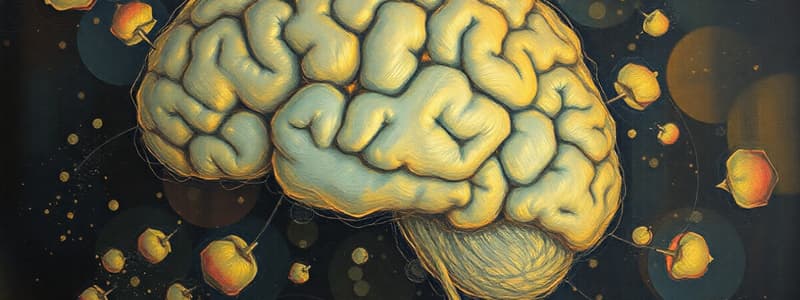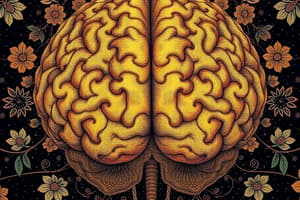Podcast
Questions and Answers
What is the main focus of cognitive neuroscience?
What is the main focus of cognitive neuroscience?
- Exploring brain development stages
- Studying brain injuries and diseases
- Understanding neural mechanisms underlying cognition (correct)
- Investigating emotional regulation
Which method is commonly used to assess electrical activity in neurons?
Which method is commonly used to assess electrical activity in neurons?
- fMRI
- CT Scan
- EEG (correct)
- PET
What role do neurotransmitters play in the nervous system?
What role do neurotransmitters play in the nervous system?
- They are involved in the physical development of the brain.
- They transmit signals across synapses. (correct)
- They provide structural support to neurons.
- They regulate electrical activity in neurons.
Which of the following brain structures is primarily involved in regulating emotions and memory?
Which of the following brain structures is primarily involved in regulating emotions and memory?
What is neuroplasticity?
What is neuroplasticity?
Clinical neuroscience primarily aims to understand which of the following?
Clinical neuroscience primarily aims to understand which of the following?
Which of these techniques is used in neuroscience to assess brain activity through blood flow?
Which of these techniques is used in neuroscience to assess brain activity through blood flow?
Which is NOT a major division of neuroscience?
Which is NOT a major division of neuroscience?
Flashcards are hidden until you start studying
Study Notes
Overview of Neuroscience
- Definition: Neuroscience is the scientific study of the nervous system, encompassing its structure, function, development, and pathology.
- Interdisciplinary Field: Integrates biology, psychology, chemistry, physics, and computer science.
Major Divisions
-
Cognitive Neuroscience:
- Focuses on the neural mechanisms underlying cognition (e.g., perception, memory, language).
- Utilizes brain imaging techniques (fMRI, PET).
-
Behavioral Neuroscience:
- Examines the relationship between behavior and the brain.
- Studies how brain injuries or diseases affect behavior.
-
Developmental Neuroscience:
- Investigates how the nervous system develops from embryonic stages to adulthood.
- Explores critical periods for brain development.
-
Clinical Neuroscience:
- Focuses on neurological and psychiatric disorders.
- Aims to understand and develop treatments for conditions like Alzheimer's, Parkinson's, and schizophrenia.
Key Concepts
-
Neurons:
- Basic building blocks of the nervous system.
- Specialized cells that transmit information via electrical and chemical signals.
-
Synapses:
- Junctions between neurons where communication occurs.
- Can be excitatory or inhibitory.
-
Neurotransmitters:
- Chemical messengers (e.g., dopamine, serotonin) that transmit signals across synapses.
- Play a crucial role in mood, sleep, and cognition.
-
Brain Structures:
- Cerebral Cortex: Involved in higher-level functions (thought, memory).
- Limbic System: Regulates emotions and memory (includes the hippocampus and amygdala).
- Brainstem: Controls vital functions (breathing, heart rate).
Techniques in Neuroscience Research
- Electrophysiology: Measures electrical activity of neurons.
- Imaging Techniques:
- fMRI: Assesses brain activity by measuring blood flow.
- EEG: Records electrical activity of the brain's surface.
- Genetic Techniques: Used to study genetic influences on brain function and behavior.
Current Trends in Neuroscience
- Neuroplasticity: The brain's ability to reorganize itself by forming new neural connections throughout life.
- Connectomics: Mapping the brain's neural connections to understand its function.
- Neuroethics: Examines the implications of neuroscience research on ethics and society.
Applications of Neuroscience
- Medicine: Development of treatments for neurological and mental disorders.
- Education: Enhancing learning methods based on how the brain processes information.
- Artificial Intelligence: Insights from neuroscience influencing AI and machine learning algorithms.
Overview of Neuroscience
- Neuroscience studies the nervous system's structure, function, development, and pathology.
- It is an interdisciplinary field incorporating biology, psychology, chemistry, physics, and computer science.
Major Divisions
-
Cognitive Neuroscience:
- Investigates neural bases of cognition including perception, memory, and language.
- Employs brain imaging techniques like fMRI (functional Magnetic Resonance Imaging) and PET (Positron Emission Tomography).
-
Behavioral Neuroscience:
- Explores the link between behavior and brain functions.
- Analyzes effects of brain injuries and diseases on behavior patterns.
-
Developmental Neuroscience:
- Studies nervous system development from embryonic stage to adulthood.
- Focuses on critical developmental periods affecting brain growth.
-
Clinical Neuroscience:
- Concentrates on understanding and treating neurological and psychiatric disorders.
- Research targets conditions such as Alzheimer's disease, Parkinson's disease, and schizophrenia.
Key Concepts
-
Neurons:
- Serve as the nervous system's building blocks, communicating via electrical and chemical signals.
-
Synapses:
- Serve as junctions for neuronal communication, functioning as either excitatory or inhibitory.
-
Neurotransmitters:
- Chemical messengers that facilitate signal transmission across synapses, key players in regulating mood, sleep, and cognition.
-
Brain Structures:
- Cerebral Cortex: Critical for higher cognitive functions including thoughts and memories.
- Limbic System: Manages emotions and memory; key components include the hippocampus and amygdala.
- Brainstem: Governs essential life functions like breathing and heart rate.
Techniques in Neuroscience Research
-
Electrophysiology: Technique to measure neuronal electrical activity.
-
Imaging Techniques:
- fMRI: Monitors brain activity through blood flow changes.
- EEG (Electroencephalography): Captures electrical activity at the brain's surface.
-
Genetic Techniques: Examine genetic factors influencing brain function and behavior.
Current Trends in Neuroscience
- Neuroplasticity: Illustrates the brain's capability to reorganize and form new neural connections throughout life.
- Connectomics: Focus on mapping neural connections to enhance understanding of brain functions.
- Neuroethics: Investigates ethical and societal implications surrounding neuroscience research.
Applications of Neuroscience
- Medicine: Drives advancements in treatments for mental and neurological disorders.
- Education: Informs development of improved learning strategies grounded in brain function understanding.
- Artificial Intelligence: Influences AI and machine learning algorithms through insights derived from neuroscience.
Studying That Suits You
Use AI to generate personalized quizzes and flashcards to suit your learning preferences.



